Teachers Create New Lessons from Old Artworks: Day 4 of the Seminar
July 28th, 2011
After three jam-packed days of tours, art-making activities, and discussions in the galleries, teachers worked hard to develop an arts-integrated lesson with a very challenging deadline—that is, by tomorrow!
If you participated in today’s program, leave a comment based on tonight’s reading assignments. What is one idea for a meaningful art-making activity that is developmentally appropriate for the grade level you teach?
- Cheddar scones, pecan scones, mango tea bread, fresh fruit = YUM!
- Intern Jocelyn Cheung demonstrates how to create cyanotypes.
- Teachers arranged a variety of shapes to “print” onto the light-sensitive paper.
- No dangerous chemicals are necessary for this photographic process! Water is all you need.
- Third grade teachers look closely at one of our newest acquisitions, Joseph M.W. Turner’s Modern Rome–Campo Vaccino.
- Educator Theresa Sotto shows teachers examples of “closed” questions that shut down conversation rather than provoke further discussion.
- Teachers work together to write discussion questions about Van Gogh’s Irises.
- Educator Veronica Alvarez discusses the art of developing good questions about works of art.
- A teacher reads background information about a painting in order to help him formulate good discussion questions.
- Educator Kelly Williams introduces teachers to resources available to them in the Education Resource Center.
- Teachers work in teams to develop their own lesson plans inspired by Getty works of art.
Categories:
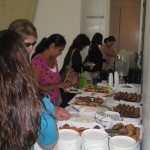

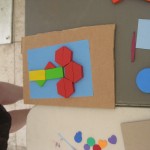

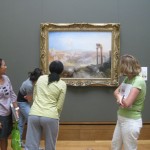


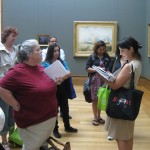
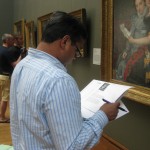

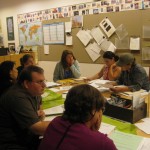
An idea for a meaningful art-making activity that is developmentally appropriate for the combination Kindergarten/1st Grade Special Education classroom that I teach would be one very similar to that of the art activity developed by the Kindergarten grade level team for our lesson plan being presented on Friday. The activity involves the students utilizing crayons/oil pastels to draw the various lines in various colors all over their paper. They then paint over their masterpiece with watercolors of their choice. This activity builds upon new vocabulary (lines, shapes, and colors) as well as their developmental level of developing their gross motor skills with simple lines and shapes. Before the “tadpoles”, as described in the reading as children’s beginning art skills, can progressively grow into adult frogs, the developed ability to produce more complex objects, they must spend time in each stage of life, losing their tail -basic features of objects-, develop limbs, and leap out of the depths of the waters onto land. Of course, jumping back into the water where their foundations began.
*Correction
“Of course, jumping back into the water from time to time where their foundations began.”
According to the second article we read tonight, a meaningful art lesson should be relevant to students’ lives and based on real world connections. This can be done by giving open-ended art projects where the students select their subject matter and utilize critical thinking skills to solve creative problems. Students in the 3rd through 5th grades are usually going through “The Crisis of Realism,” according to the article “Young in Art.” This concern to have their artwork be representational can lead to children’s loss of interest and willingness to participate in art-making activities. To help alleviate this, teachers of this age range need to give children the proper instruction that enables them to attain the realistic qualities they so desire in their artwork.
One idea that incorporates the ideas from both articles might be an art-making lesson that begins with focused visual description of different techniques various artists use to create a three-dimensional scene on a two dimensional surface (such as overlapping, diminishing size, linear perspective, ground planes, etc). Then have students choose their own subjects to practice drawing with perspective. Since they’ve been exposed to a variety of techniques, they can try to solve the creative problem of arranging things in relation to each other on the page in a realistic fashion. Furthermore, since they choose the subject themselves, it allows for it to be relevant to each student individually and for them to make their own meanings.
I was excited to get to visit the research center and learn about the things available to us as members of ALA. I fell in love with the book “Going to the Getty”. It is so nice to be given the opportunity to have materials availabe to us at no cost. It will definitely enrich my students’ learning to have Xerox copies of art work at their fingertips as I present art lessons based on famous art work. Then to actually see the art work when we come to the Getty will be the be “Wow” factor. I know from past experiences at my school that for most of the students there, the only exposure to quality art is what their teachers show them.
Kudos to Theresa and others in the education department. Thank you to all who have made my week of learning a wonderful time.
Hi! I love the project on light reflective paper we did in the morning. That is definitely one I’d like to share with the students.
I bought a book called “The Usborne Complete Book of Art Ideas” for only $20 from the Getty Bookstore. It would probably be $40+ elsewhere. It is packed full of fun art activities of all kinds that I can’t wait to try not only in the classroom but with my own 5-year-old son!
Thanks!
Beth
One idea for a meaningful art-making activity that is developmentally appropriate for my grade level (kinder) would be to give them an opportunity to explore media through a hands on approach.As stated in Young in Art “…the best contribution that the teacher or parent can make is offer children the proper materials and encouragement to engage in scribbling”. I plan on doing this by proving different media of art at the students centers in hopes of developing their creativity, fine motor skills and self expression.
Reading the article Young in Art had me reflecting on the class of Ks that I said goodbye to in June. I remember how so many of them started the year with seemingly no experience with writing and drawing utensils. Scribbling and random symbols in pencil and crayon would appear on the brand new tables, chairs and floor. I thought they were misbehaving. The entire class would then be scolded and schooled about the appropriate places to practice their writing and drawing, and I covered the tables with butcher paper so that everyone had a space to scribble. They received weekly art instruction from a colleague who had attended the Getty Arts and Language Arts program. By the end of the year the art that they were creating was beautiful, varied and full of details.
A kinder art activity: Go on a shape hunt around the classroom, school or neighborhood; talk about the objects found; draw (outline) then cut the shapes on different colored construction paper; arrange the cut shapes (in different ways) on black construction paper creating a still life of the shapes. Use oral and written language to describing the relationship of the different colored shapes to one another.